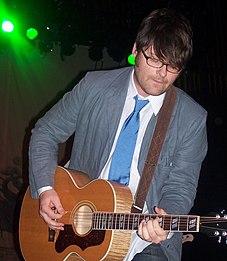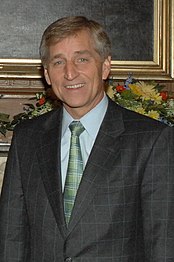
University of Montana
The University of Montana (UMT or UM) is a public research university in Missoula, Montana. UMT is a flagship institution of the Montana University System[5] and its second largest campus. UMT reported 10,962 undergraduate and graduate students in the fall of 2018. It is classified among "R1: Doctoral Universities – Very high research activity" as of 2022.[6]
This article is about the main campus in Missoula. For other campuses, see Montana University System.The University of Montana ranks 17th in the nation and fifth among public universities in producing Rhodes Scholars;[7] it has 11 Truman Scholars, 14 Goldwater Scholars, and 40 Udall Scholars to its name.[8][9] One alumnus, Harold Urey, has won the Nobel Prize.[10]
Academic rankings
610
254
205
> 600
601-700
801-1000
736
The original plan of the campus was designed by one of its first professors, Frederich Scheuch, who called for the central oval to be surrounded by immediate and future university buildings. Although Scheuch's plan called for all building entrances to face the center of the Oval, forming a radiating building pattern, buildings were later constructed with three-story in the Renaissance Revival style, with hipped roofs and Spanish green roof tiles.
The first set of buildings were set up around the oval in 1895. Since that time, various campus plans and architectural styles have been used. Today the campus consists of 220 acres (89 ha) and is bordered to the east by Mount Sentinel and the north by the Clark Fork River. The main campus comprises 64 buildings, including nine residence halls and various athletic venues, including Washington–Grizzly Stadium, a 26,500-seat football stadium and the Adams Center (formerly, Dahlberg Arena), a 7,500-seat multi-purpose arena where the university's basketball teams play.
Landmarks include:
A three-acre (1.2 ha) swath of grass running east to west, marking the traditional center of the university. Today it is divided into quadrants by two intersecting brick-laid paths, though originally the oval was solid grass and forbidden to be crossed by students. A double row of trees was planted around the oval on Arbor Day 1896, but many of the trees have since died and are in the process of being replanted. The original gravel driveway that once surrounded the Oval has also been replaced by sidewalk. The original master plan of the university called for all buildings to face the center of the oval, but this plan proved difficult and a new plan was created in 1935.
On the western extreme of the Oval is a life-sized grizzly bear statue created by ceramic artist and sculptor Rudy Autio in 1969.[20] The bronze statue is 7 feet (2.1 m) in height, weighs 5,000 pounds (2,300 kg), and took a year to create.[21] Many photographs of the university picture the bear with the Oval, university (Main) Hall, and Mount Sentinel's 'M' in the background.
A 3⁄4-mile (1.2 km) trail with 13 switchbacks, it ascends 620 vertical feet (190 m), from 3,200 to 3,820 feet (975 to 1,165 m) above sea level, from the university at the base of Mount Sentinel. The trail offers sweeping views of the city below.
There is debate of when "The 'M'" was first placed on Mount Sentinel. Around 1908, members of the Forestry Club forged a zigzag trail up the mountain and students carried up stones to shape the symbol of the University of Montana. Originally made of whitewashed rocks and only measuring 25 feet (7.6 m) by 25 feet, the very first "M" was poorly constructed and ultimately replaced by a wooden "M" in 1912, which cost $18. That "M," unlike today's "M," stood upright on the face of Mount Sentinel. A larger wooden version of the "M" was built in 1913 and upkeep of the structure was formally charged to each year's freshman class.
When the large wooden "M" was destroyed by a blizzard in 1915, an even larger version was constructed of whitewashed granite. Once again the freshman class was tasked with annual renovation of the symbol, beginning a new tradition. Each year from then on, University of Montana freshmen made the hike up to the "M" to apply a fresh coat of whitewash and remove any weeds and grass that had grown in and around the structure.
The annual tradition ended in 1968 when a 125-by-100-foot (38 by 30 m) concrete "M" was built at a cost of $4,328. Behind the decision to replace rock with concrete were maintenance issues; with the coming of the 1960s, UM students exhibited waning enthusiasm for the annual trek up the hill and for annual upkeep of the "M". Although the annual whitewashing went by the wayside, one tradition that lives on today is the lighting of the "M" during the university's annual Homecoming celebration each fall. Originally lit by a group of students on October 9, 1919, following the fall whitewashing, the event was so popular that students have continued to light the "M" each year during Homecoming week; special beacons light up the giant letter, welcoming former students back to the university.[22]
On the north side of campus, 29 evergreen trees stand in two columns forming Memorial Row along what used to be the path of Van Buren Avenue. The trees, running from the corner of the Oval to Eddy Avenue, were planted in 1919 following the end of the Great War to honor UM students, alumni, and faculty who died in the war, some to combat and many more to the influenza epidemic. The trees are Pinus ponderosa (Western Yellow Pines or Ponderosa Pine), the state tree of Montana. Originally, a white T-board stood in front of each tree, with the name of the person whom it honors; in 1925, these were replaced with 35 brass nameplates atop concrete markers. At the same time, the university added a memorial tablet on a boulder near the edge of the Oval closest to Memorial Row. It lists 21 of the 31 honorees from 1919. By 1925, the university had increased the number of names on the official list to 35, and sometime later, it grew to 37.[23]
Points of interest include:
Organization and administration[edit]
Administration[edit]
The University of Montana is the main campus for the university, which includes four other campuses. The public university system is one of two in Montana; the other is Montana State University. Both systems are governed as the Montana University System by the Montana Board of Regents, which consists of seven members appointed by the state governor, and confirmed by the state Senate to serve overlapping terms of seven years, except for one student member who is appointed for one year at a time.. The governor and Superintendent of Public Instruction, both statewide elected officials, are ex officio members of the Board, as is the Commissioner of Higher Education, who is appointed by the Board of Regents.[24]
The Board of Regents appoints the university president, who is directly responsible and accountable to the Commissioner of Higher Education.[25]
Campus media[edit]
The Montana Kaimin, founded in 1898, is the student-run college newspaper. It is independent of the university. It attracted national attention in 2009, when football coach Bobby Hauck refused to take questions from the paper in retaliation for a story about an alleged assault by two Grizzly football players.[27] The Montanan is the university's alumni magazine, published by the University Relations office. CutBank, founded in 1973 by the Creative Writing Program, is a literary magazine. Camas: The Nature of the West, is a literary journal run by graduate students of the Environmental Studies Program.
KBGA (89.9 FM) is the college radio station. KUFM-FM is the flagship and founding station of Montana Public Radio. Founded in 1965, its studios are located in the Broadcast Media Center, of the Performing Arts/Radio Television Center. KUFM-TV (Channel 11) is the local Montana PBS station.
The athletic teams are nicknamed the Montana Grizzlies, often shortened to Griz or Lady Griz (Lady Griz is only used when referring to the women's basketball team; all other women's teams are known as the Griz). The university has competed in the NCAA's Big Sky Conference since the conference was formed in 1963. From 1924 to 1950, the University of Montana was a member of the Pacific Coast Conference (precursor to today's Pac-12). The University of Montana has an ongoing rivalry with Montana State University, most notably the cross-state football matchups, known as the "Brawl of the Wild", but also includes the cross-state club lacrosse matchup, known as the "Copper Cup".
Programs include:
Other intercollegiate sports include men's and women's cross country, women's golf, men's and women's track and field, men's and women's indoor track and field, men's and women's tennis, women's volleyball and women's soccer. In 2015 UM added women's softball.
Intramural sports include men's lacrosse (won 2007 national championship in their division, MCLA-B) and women's lacrosse, the Alpine Ski Team (went to the national championships in winter 2006), rowing, dance and cheer, men's and women's ice hockey, men's soccer, the Woodsman Team, rodeo, the Missoula Footbag Alliance. triathlon, cycling, fencing, Jesters Rugby, and Betterside Women's Rugby.
The mascot of the university is Monte, a Grizzly Bear. In 1897, a live bear cub traveled with UM's football team, then known as the "Bears" (the "Grizzlies" name was adopted in 1923). Numerous live bear cubs who served as university mascots, first named Teddy, then Fessy and finally, in the 1960s, Cocoa. UM's costumed mascot during the 1980s, dubbed Otto, donned a variety of fun-loving outfits to entertain crowds at Grizzly football games. Monte (short for Montana) was born in the mountains of Missoula in the fall 1993. The 2002–03 and 2004–05 National Champion Mascot of the Year (Capital One/ESPN) has evolved into a "motorcycle-riding, break-dancing, back flipping, slam-dunking, movie-making, crowd-surfing, goal post smashing, prank-pulling superstar."[39]




